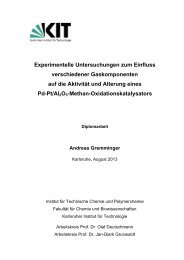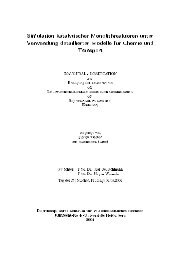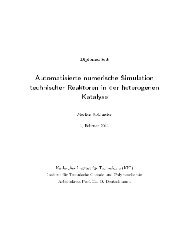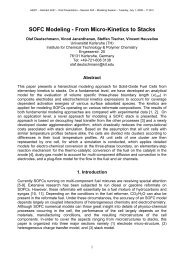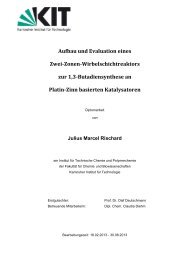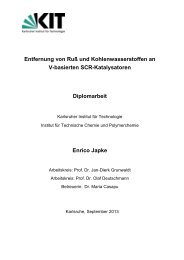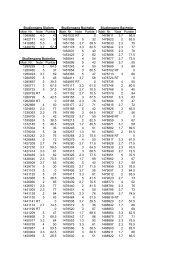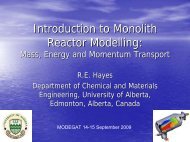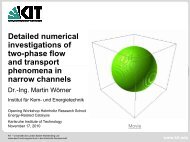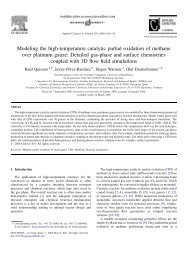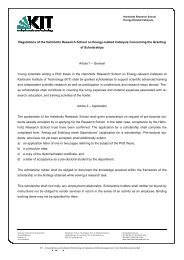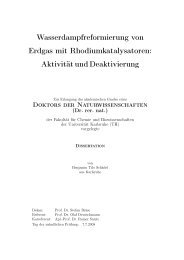Fuel Processing for Fuel Cells - Institut für Technische Chemie und ...
Fuel Processing for Fuel Cells - Institut für Technische Chemie und ...
Fuel Processing for Fuel Cells - Institut für Technische Chemie und ...
You also want an ePaper? Increase the reach of your titles
YUMPU automatically turns print PDFs into web optimized ePapers that Google loves.
Author's personal copy<br />
<strong>Fuel</strong> <strong>Processing</strong> <strong>for</strong> <strong>Fuel</strong> <strong>Cells</strong> 53<br />
1.E-02<br />
5.E-06<br />
8.E-03<br />
4.E-06<br />
Mole fraction<br />
6.E-03<br />
4.E-03<br />
C 3 –C 4 olefins<br />
PAH<br />
3.E-06<br />
2.E-06<br />
2.E-03<br />
1.E-06<br />
0.E+00<br />
0.00<br />
i-C 8 H 18 C 2 H 2<br />
C 6 H 6<br />
0.10<br />
z [m]<br />
0.20<br />
0.E+00<br />
Figure 17 Influence of gas-phase reactions on the catalyst exhaust composition in<br />
the postcatalyst zone of a CPOX re<strong>for</strong>mer (Rh/alumina honeycomb) operated with<br />
iso-octane at rich conditions (C/O¼1.6). The catalyst exhaust composition measured was<br />
fed into an empty tube heated by a furnace to a temperature of 1106 K, which was the<br />
catalyst exit temperature measured in the CPOX reactor. The figure shows the numerically<br />
predicted distribution of carbon precursors along the empty tube, thereby clearly<br />
revealing postcatalyst conversion in the downstream gas phase. C 3 –C 4 olefins contain 1,2-<br />
propadiene, propene, propyne, n-butene (1-butene, 2-butene), iso-butene, and 1,3-butadiene;<br />
PAH contains naphthalene, anthracene, and pyrene. The embedded photo shows the<br />
tubular quartz reactor after operation. Taken from Kaltschmitt et al. (2011).<br />
and selectivity. An adiabatic single-channel simulation will fail; it is not<br />
able to predict even the qualitative behavior, that is, the increase of the<br />
catalytic exit temperature with increasing flow rate as shown in Figure 18<br />
(Hartmann et al., 2011). Instead, the entire catalytic monolith with at least<br />
several representative channels has to be considered, including heat<br />
transport within the solid structure of the monolith and at all monolith<br />
bo<strong>und</strong>aries. The increase in temperature with increasing flow rates can be<br />
explained by the effect of heat losses. The total amount of heat released by<br />
the reaction almost linearly increases with the flow rate, because the fuel is<br />
fully converted in the first zone of the catalyst. However, since higher<br />
temperature favors the less exothermic POX over the highly exothermic<br />
total oxidation, a self-limiting process concerning the temperature increase<br />
occurs. Consequently, the temperatures do not increase extraordinarily<br />
with increasing flow rate. The total amount of heat loss to the ambience by<br />
means of thermal conduction and radiation mainly depends on the temperature<br />
of the solid structure, which indeed is higher, but not so much higher<br />
as to compensate <strong>for</strong> the larger heat release effect. In short, the ratio of<br />
chemical heat release to thermal heat loss increases with increasing flow



